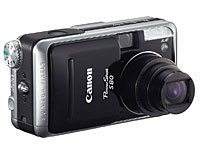 Canon has announced its new PowerShot S80 consumer camera, an eight megapixel compact camera with a wide range of auto and manual controls.
Canon has announced its new PowerShot S80 consumer camera, an eight megapixel compact camera with a wide range of auto and manual controls.
Smaller and lighter than the PowerShot S70 it replaces, the S80 sports a much larger (2.5″) wide viewing angle LCD monitor, a wide-angle 28-100 mm f/2.8-5.3 (3.6x) optical zoom lens which uses the same DIGIC II processor found in Canon’s professional series digital SLRs
The prosumer-targeted camera offers an EOS-style Multi Control Dial for quickly setting menu and shooting functions and nippily scrolling through images during playback.
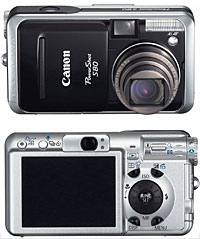 The camera packs in some advanced features including real-time histogram display, FlexiZone AF/AE with a freely movable focus point and manual focus override with 21 shooting modes taking care of most lighting conditions.
The camera packs in some advanced features including real-time histogram display, FlexiZone AF/AE with a freely movable focus point and manual focus override with 21 shooting modes taking care of most lighting conditions.
The new large 2.5″ LCD is adjustable to one of 15 brightness levels and features a “Quick-bright” function for shooting in sunny conditions (sadly, a feature of little benefit to most UK users).
There’s also a handy selectable grid line display to help with composition and keeping wobbly horizons level.
As is the norm for a compact camera, the optical viewfinder can best be described as ‘basic’ with all the shooting image being presented in the LCD screen.
The little fella (104 x 57 x 39 mm) can also record quality video clips up to 1 GB in size, from 320 x 240 at 30/15 fps right up to 1024 x 768 at 15 fps.
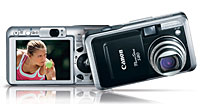 Surprisingly, RAW capture has been left off the spec list, although there’s USB 2.0 compatibility to help speedily transfer images to a PC speedily.
Surprisingly, RAW capture has been left off the spec list, although there’s USB 2.0 compatibility to help speedily transfer images to a PC speedily.
“The PowerShot S80 provides those serious about photography with uncompromising specifications,” gushed Mogens Jensen, Head of Canon Consumer Imaging Europe. “Its futuristic and compact design symbolises Canon’s commitment to pushing the limits of what is possible in this important segment.”
The camera’s 8.0 Megapixel sensor produces images for detailed A3+ size prints, with auto focus speeds claimed to 20% faster.
The S80 is expected to retail for around $549 (£322, €475) when it hits the stores in October 2005.
 It’s farewell to film at Dixons, as the company announced that it would no longer stock 35mm film-based cameras.
It’s farewell to film at Dixons, as the company announced that it would no longer stock 35mm film-based cameras. 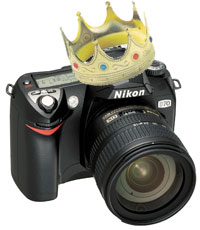 After reaching a peak in the UK of 2.9 million cameras sold in 1989, 35mm camera sales have been steadily falling, with the public being wooed by the convenience, improving quality and falling costs of consumer digital cameras.
After reaching a peak in the UK of 2.9 million cameras sold in 1989, 35mm camera sales have been steadily falling, with the public being wooed by the convenience, improving quality and falling costs of consumer digital cameras.  “Time and technology move on … digital cameras are now the rule, rather than the exception. We have decided that the time is now right to take 35mm cameras out of the frame,” Magrath added.
“Time and technology move on … digital cameras are now the rule, rather than the exception. We have decided that the time is now right to take 35mm cameras out of the frame,” Magrath added. 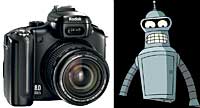 Kodak has announced a new class of ‘advanced digital cameras’ aimed at grabbing a slice of the burgeoning dSLR market.
Kodak has announced a new class of ‘advanced digital cameras’ aimed at grabbing a slice of the burgeoning dSLR market. 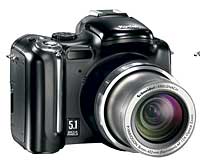 Looking down the range, Kodak have also announced their 5.3 megapixel EasyShare P850 camera, featuring a 12X, 36 – 432mm (35mm equiv.), f2.8 – f/3.7, Schneider-Kreuznach Variogon lens with optical image stabilisation.
Looking down the range, Kodak have also announced their 5.3 megapixel EasyShare P850 camera, featuring a 12X, 36 – 432mm (35mm equiv.), f2.8 – f/3.7, Schneider-Kreuznach Variogon lens with optical image stabilisation.  Sony has today announced the latest update to its range of ultra-slim DSC-T digital cameras, the Sony Cyber-Shot DSC-T5.
Sony has today announced the latest update to its range of ultra-slim DSC-T digital cameras, the Sony Cyber-Shot DSC-T5. 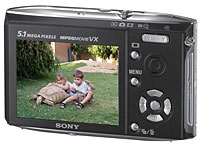 There are a slew of pre-set picture-taking modes onboard to help point’n’shooters get the best from the camera, with a “Magnifying Glass” feature allowing macro shooting up to 1cm from an object and a “High Speed Shutter” to catch fast-moving action.
There are a slew of pre-set picture-taking modes onboard to help point’n’shooters get the best from the camera, with a “Magnifying Glass” feature allowing macro shooting up to 1cm from an object and a “High Speed Shutter” to catch fast-moving action. 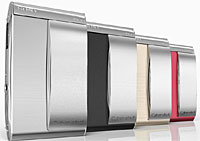 This has resulted in the company dramatically cutting its forecast earnings from ¥80 billion (~$712m ~£403m ~€582m) to ¥10 billion (~$89m ~£50.3m ~€72.8m).
This has resulted in the company dramatically cutting its forecast earnings from ¥80 billion (~$712m ~£403m ~€582m) to ¥10 billion (~$89m ~£50.3m ~€72.8m). 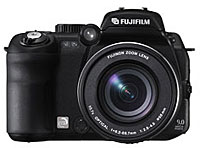 FinePix S9000 Zoom
FinePix S9000 Zoom 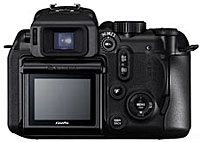 The compact-based design means that – unlike dSLRs – the camera can offer 30-frames-per-second movie mode (with a manual zoom capability) – something that may prove tempting to punters after a high quality ‘do it all’ camera.
The compact-based design means that – unlike dSLRs – the camera can offer 30-frames-per-second movie mode (with a manual zoom capability) – something that may prove tempting to punters after a high quality ‘do it all’ camera. 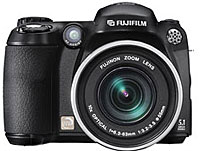 Second up is the Fujifilm FinePix S5200 Zoom, the third incarnation of Fujifilm’s S series cameras.
Second up is the Fujifilm FinePix S5200 Zoom, the third incarnation of Fujifilm’s S series cameras.  Finally, we come to the Fujifilm FinePix E900 Zoom, a new E series “pocket friendly” compact managing to pack 9 million effective pixels into its lithe proportions.
Finally, we come to the Fujifilm FinePix E900 Zoom, a new E series “pocket friendly” compact managing to pack 9 million effective pixels into its lithe proportions. 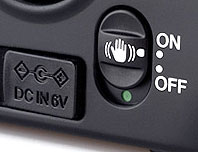 Konica Minolta and Sony Corporation have reached an agreement to jointly develop digital Single Lens Reflex (dSLR) cameras.
Konica Minolta and Sony Corporation have reached an agreement to jointly develop digital Single Lens Reflex (dSLR) cameras. 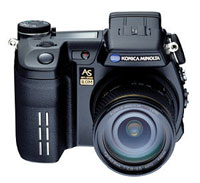 With Sony bringing their award-winning design expertise to the party – and their image sensor, image processing and battery technologies – we can expect some smarty-pants new product design to emerge from the partnership.
With Sony bringing their award-winning design expertise to the party – and their image sensor, image processing and battery technologies – we can expect some smarty-pants new product design to emerge from the partnership. 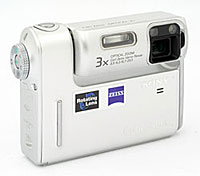 As prices of dSLR’s plummeted, the writing was on the wall for high-end fixed-lens models, so Sony’s move into the dSLR market was not unexpected.
As prices of dSLR’s plummeted, the writing was on the wall for high-end fixed-lens models, so Sony’s move into the dSLR market was not unexpected. 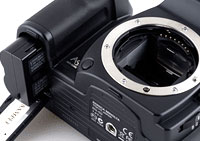 “Sony has powerful devices and technologies essential for digital cameras,” praised Tsuyoshi Miyachi, President and CEO of Konica Minolta Photo Imaging. “I am extremely excited to work with Sony. Together with Sony, we will endeavour to create new value in the field of imaging through increasing attractiveness of digital SLR cameras where we are strongly focused.”
“Sony has powerful devices and technologies essential for digital cameras,” praised Tsuyoshi Miyachi, President and CEO of Konica Minolta Photo Imaging. “I am extremely excited to work with Sony. Together with Sony, we will endeavour to create new value in the field of imaging through increasing attractiveness of digital SLR cameras where we are strongly focused.” 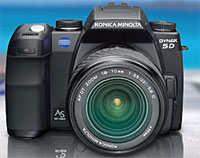 It wasn’t that long ago that digital dSLRs were the sole preserve of well-heeled enthusiasts and the pestering paparazzi, but with prices continuing to fall, digital dSLRs are coming within the reach of the mainstream.
It wasn’t that long ago that digital dSLRs were the sole preserve of well-heeled enthusiasts and the pestering paparazzi, but with prices continuing to fall, digital dSLRs are coming within the reach of the mainstream.  In February this year, Canon returned with its cheaper-faster-more featured next generation 8 megapixel camera, the EOS350D (Digital Rebel XT) retailing for US$880 (~£503, ~€728) while Nikon’s similarly priced D50 was introduced in April.
In February this year, Canon returned with its cheaper-faster-more featured next generation 8 megapixel camera, the EOS350D (Digital Rebel XT) retailing for US$880 (~£503, ~€728) while Nikon’s similarly priced D50 was introduced in April. 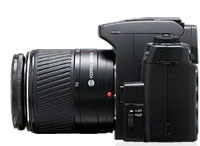 The rest of the specs of the camera are impressive but not cutting edge: 6.1 megapixel sensor, JPEG and RAW image capture (RAW: 3 fps, up to 5 frames), white-balance bracketing, 100-3200 ISO, built-in pop flash and USB 2.0.
The rest of the specs of the camera are impressive but not cutting edge: 6.1 megapixel sensor, JPEG and RAW image capture (RAW: 3 fps, up to 5 frames), white-balance bracketing, 100-3200 ISO, built-in pop flash and USB 2.0.  The growth of photo and video-capable phones has resulted in news agencies sourcing more and more content from members of the public who have used their mobiles to record disaster scenes.
The growth of photo and video-capable phones has resulted in news agencies sourcing more and more content from members of the public who have used their mobiles to record disaster scenes.  Jonathan Klein, CNN’s U.S. chief believes this “citizen journalism” will become a more important part of coverage in major news events. “No question about it,” he said. “There’s been a lot of talk in terms of the increased democratization of the news media relating to blogs and the like. This is another example of the citizen journalist.”
Jonathan Klein, CNN’s U.S. chief believes this “citizen journalism” will become a more important part of coverage in major news events. “No question about it,” he said. “There’s been a lot of talk in terms of the increased democratization of the news media relating to blogs and the like. This is another example of the citizen journalist.” 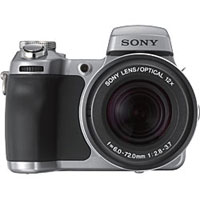 Barging its way into the crowded 5 megapixel “super zoom” market is Sony’s new Cyber-shot DSC-H1 camera.
Barging its way into the crowded 5 megapixel “super zoom” market is Sony’s new Cyber-shot DSC-H1 camera. 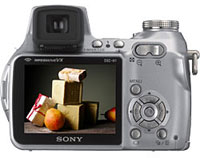 The DSC-H1 sports a fairly small but bright 115,200 pixels electronic viewfinder (EVF) that mirrors the information displayed on the main screen.
The DSC-H1 sports a fairly small but bright 115,200 pixels electronic viewfinder (EVF) that mirrors the information displayed on the main screen.  Shutter speeds range from 30 to 1/1000 second, and the camera comes with optical image stabilisation built in (although Sony likes to call it Super Steady Shot’).
Shutter speeds range from 30 to 1/1000 second, and the camera comes with optical image stabilisation built in (although Sony likes to call it Super Steady Shot’). 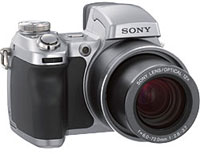 There’s enough manual controls to ensure that adventurous photographers can stay in control of their exposures, with a wide selection of scene modes covering most eventualities.
There’s enough manual controls to ensure that adventurous photographers can stay in control of their exposures, with a wide selection of scene modes covering most eventualities.  Yahoo has announced plans to ramp up the feature set of its
Yahoo has announced plans to ramp up the feature set of its  The service currently only allows users to include content from other Yahoo services such as Yahoo Photos and Yahoo Music, but now Yahoo are to offer the inclusion of RSS (Really Simple Syndication) feeds from other sources.
The service currently only allows users to include content from other Yahoo services such as Yahoo Photos and Yahoo Music, but now Yahoo are to offer the inclusion of RSS (Really Simple Syndication) feeds from other sources.